Key takeaways:
- Educational publishing should include diverse perspectives to foster empathy, understanding, and a sense of belonging among students.
- Inclusive textbooks validate students’ identities, inspire engagement, and promote critical thinking by providing a variety of cultural narratives.
- Strategies such as collaborative projects and feedback from students can enhance the representation of diverse voices in educational materials.
- The future of educational publishing relies on technological integration and community collaboration to create truly inclusive and transformative learning experiences.
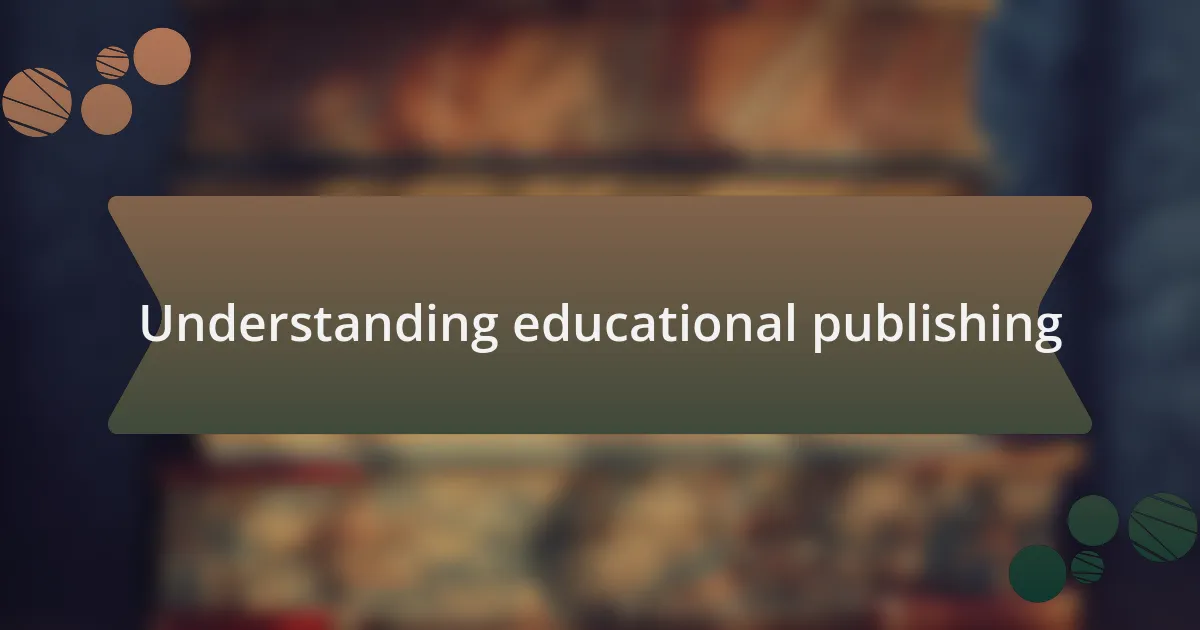
Understanding educational publishing
Educational publishing is a dynamic and evolving field that plays a crucial role in shaping how knowledge is disseminated. I remember the first time I held a textbook that intricately wove different cultural perspectives into its fabric. It sparked a realization that education extends beyond mere facts; it becomes a gateway for students to explore diverse worldviews. Isn’t it fascinating how a textbook can be a tool for empathy and understanding?
As I delved deeper into the industry, I often asked myself: how can we ensure that educational materials reflect the complexity of our society? The answer lies in collaboration with educators, cultural experts, and communities themselves. By actively involving various voices in the creation process, publishers can produce content that resonates with all learners, rather than a select few.
In my experience, the challenge often comes down to balancing the need for comprehensive information with accessibility. I’ve seen firsthand how textbooks with varied perspectives not only illuminate themes but also engage students on a personal level. Isn’t it powerful to think that the right textbook can inspire a young person to see themselves in history or science? This blend of relevance and representation is what defines effective educational publishing today.
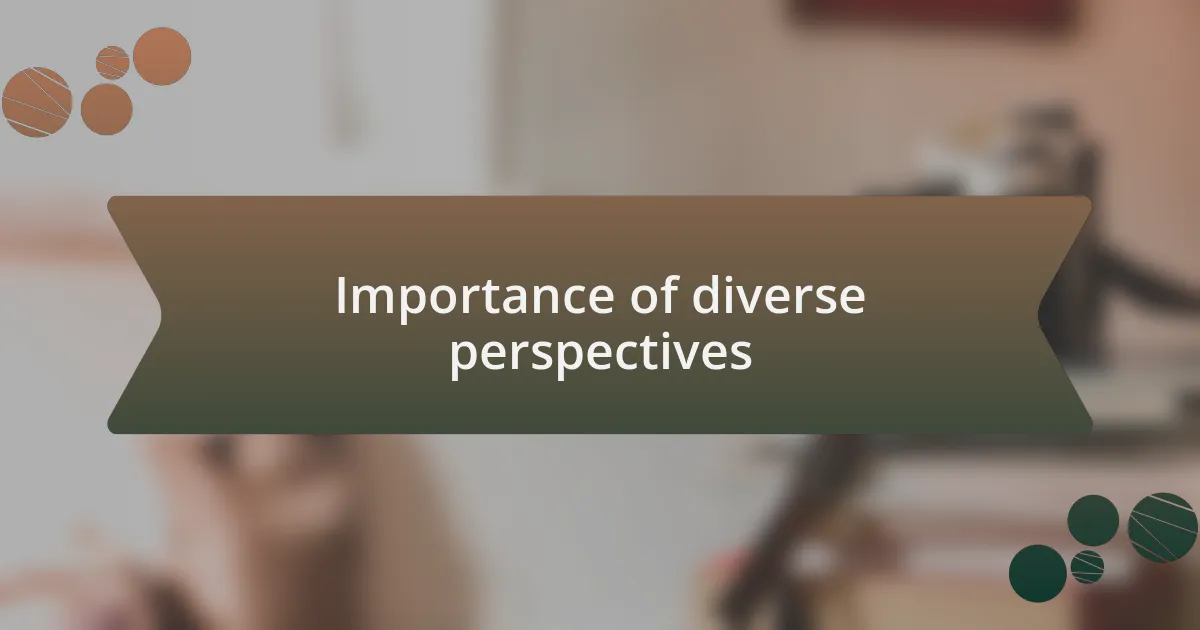
Importance of diverse perspectives
Diverse perspectives in textbooks are crucial because they foster inclusivity and promote a sense of belonging among students. I once taught a lesson using a history textbook that included narratives from underrepresented communities. The moment a student identified with a story that mirrored their own background was enlightening. It made me realize how powerful representation can be in cultivating a classroom environment where every voice feels valued.
When I reflect on my own educational journey, I remember the moments I learned not just from the mainstream narratives but also from the lesser-known stories that sparked my curiosity. Those experiences taught me that textbooks should not only inform but also inspire students to explore beyond their immediate surroundings. Isn’t it remarkable how the inclusion of various viewpoints can drive engagement and deepen understanding?
Moreover, embracing diverse perspectives prepares students for the global society they will navigate as adults. I’ve observed how incorporating varied cultural insights has led to richer classroom discussions, encouraging students to challenge their preconceived notions. Have you ever noticed how a single story can open up a world of dialogue? It’s this kind of exchange that not only enhances academic learning but also cultivates critical thinkers who appreciate complexity—an essential skill for the future.

Benefits of inclusive textbooks
Inclusive textbooks offer a myriad of benefits, particularly in shaping empathetic individuals. I remember the first time I used a textbook featuring stories from various cultures during a literature class. The students were not just reading; they were connecting, laughing, and sometimes even gasping as they encountered experiences radically different from their own. This emotional engagement transformed our discussions, revealing layers of understanding that would not have surfaced with a more traditional approach.
When students see themselves represented in the material they study, it fosters a sense of pride and validation. I recall a student sharing how learning about scientists from her culture empowered her to pursue her passion for STEM. It made me ponder: how often do we overlook the potential inspiration that diverse stories provide? The ripple effect of such affirmative experiences is tremendous, leading students to believe that they can shape their own narratives.
Additionally, inclusive textbooks prepare learners for the diverse world beyond the classroom walls. In my experience, introducing perspectives from different cultures has enriched our conversations surrounding global issues. I’ve seen students actively shift their views and challenge biases they didn’t know they held. Doesn’t it speak volumes when a textbook can spark curiosity and cultivate a more expansive worldview? This transformational potential makes inclusive textbooks not only an asset but a necessity in education today.
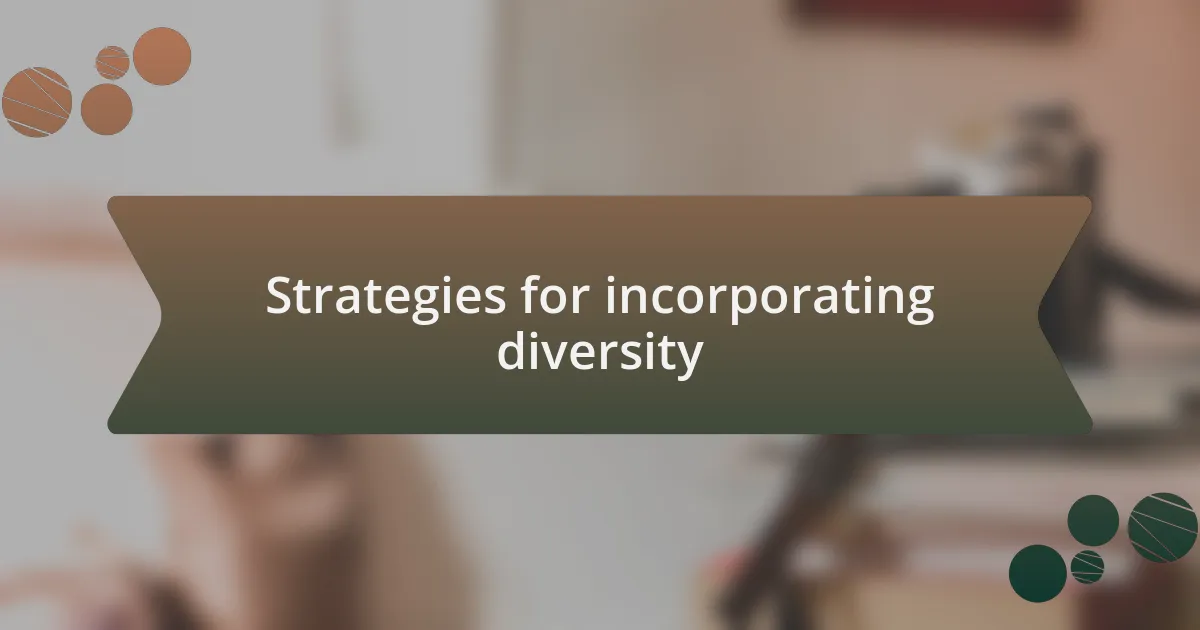
Strategies for incorporating diversity
Incorporating diverse perspectives in textbooks starts with intentional content selection. I often recommend curating materials that highlight voices from underrepresented groups. For example, while designing a history curriculum, I included narratives from Indigenous peoples, which transformed the way students viewed historical events. It was a revelation for them when they realized there were multiple sides to a story they had always accepted as one-dimensional.
Engaging students through collaborative projects is another effective strategy. I love facilitating group work where students research and present on various cultural contributions to a common topic. It’s incredible how, through collaboration, students not only learn from a textbook but also from each other. When I observed a shy student step up to share his findings on African art, I saw him gain confidence while simultaneously igniting interest in his classmates about perspectives they hadn’t previously considered.
Lastly, continuous feedback is vital in this process. I always encourage educators to gather insights from students regarding their experiences with the materials. Are they resonating with the diverse perspectives presented? When I once asked a class about the representation in a textbook, the responses opened my eyes to overlooked biases and prompted revisions that made the content even richer. Engaging in dialogue about diversity isn’t just a one-time effort; it’s a dynamic process requiring adjustment and growth.

Analyzing representation in content
When delving into the representation within educational content, I often find it eye-opening to scrutinize the images and narratives we present to students. One time, I reviewed a science textbook and noticed that all the featured scientists were predominantly from similar backgrounds, which left me wondering: where are the diverse voices that have shaped our understanding of the world? This realization pushed me to advocate for more inclusive profiles, allowing students to see themselves reflected in all fields, not just the traditional narratives.
I’ve also observed that the language we use plays a crucial role in representation. During one curriculum review, I discovered that certain terminology inadvertently reinforced stereotypes, which made me uncomfortable. How can we expect students to embrace diversity if the language they encounter is limiting? I made it a point to suggest more inclusive language that recognizes everyone’s contributions while fostering an environment of respect and understanding.
Another important aspect is the stories we choose to tell and the cultures we highlight. I remember a project where students were assigned to explore folk tales from various cultures. The discussions that sprang from these stories illuminated so many different values and traditions that my students had never encountered. It struck me then: by analyzing what narratives we include, we not only educate but also enrich the emotional landscape of our classrooms, promoting empathy and a broader worldview.
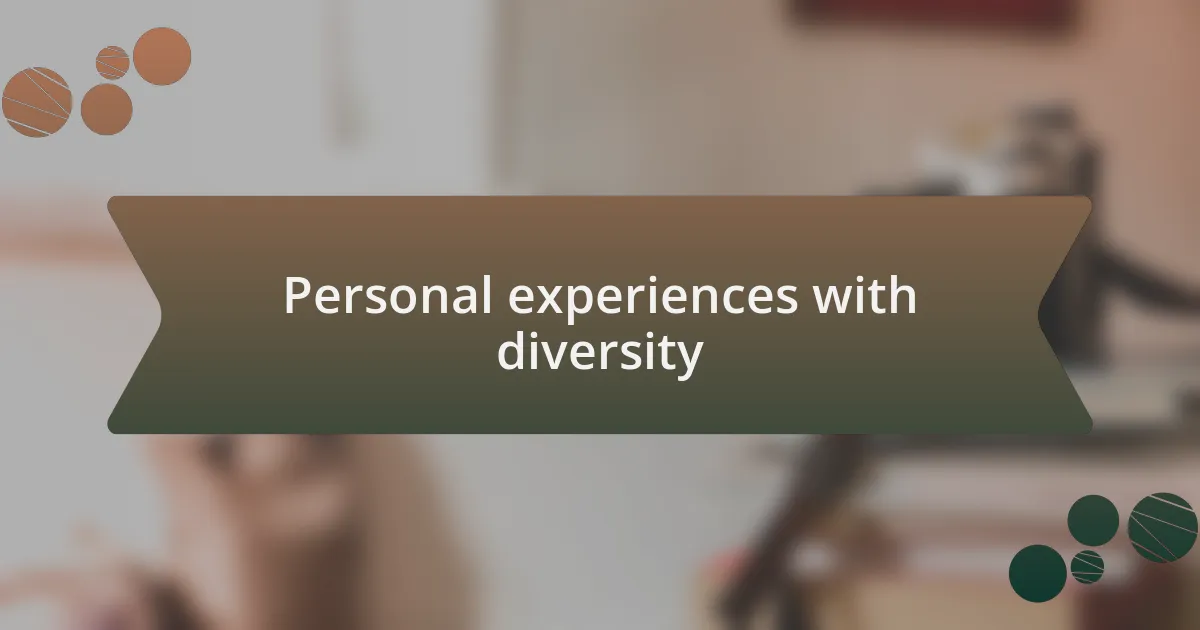
Personal experiences with diversity
I’ve had my share of experiences where diversity in education truly came alive. One memorable moment was during a teacher training workshop, where we discussed the importance of including diverse perspectives in history lessons. As I listened to my colleagues share their stories of cultural identity, I felt a mix of pride and frustration. It made me realize how essential it is for students to not only learn about diversity but to see their own histories celebrated and recognized in the classroom.
On a more personal note, I once had a student from a marginalized community who struggled to connect with the mainstream curriculum. I decided to introduce literature from his culture, which sparked a transformation in his attitude. I can still remember the beaming smile on his face as he recognized elements from his own life in the texts we studied. It raised a significant question for me: how many other students are silently craving that connection? That experience taught me firsthand that representation doesn’t just matter; it can empower students in profound ways.
I often reflect on a conversation I had with a parent from a diverse background who expressed their concern about their child’s education. They shared how the lack of diverse narratives made their child feel unseen. This interaction stuck with me, prompting me to advocate for a more inclusive curriculum. It reinforces the idea that our educational materials should not just serve to inform but also to unite. After all, haven’t we all felt the relief of finally having our voices heard?
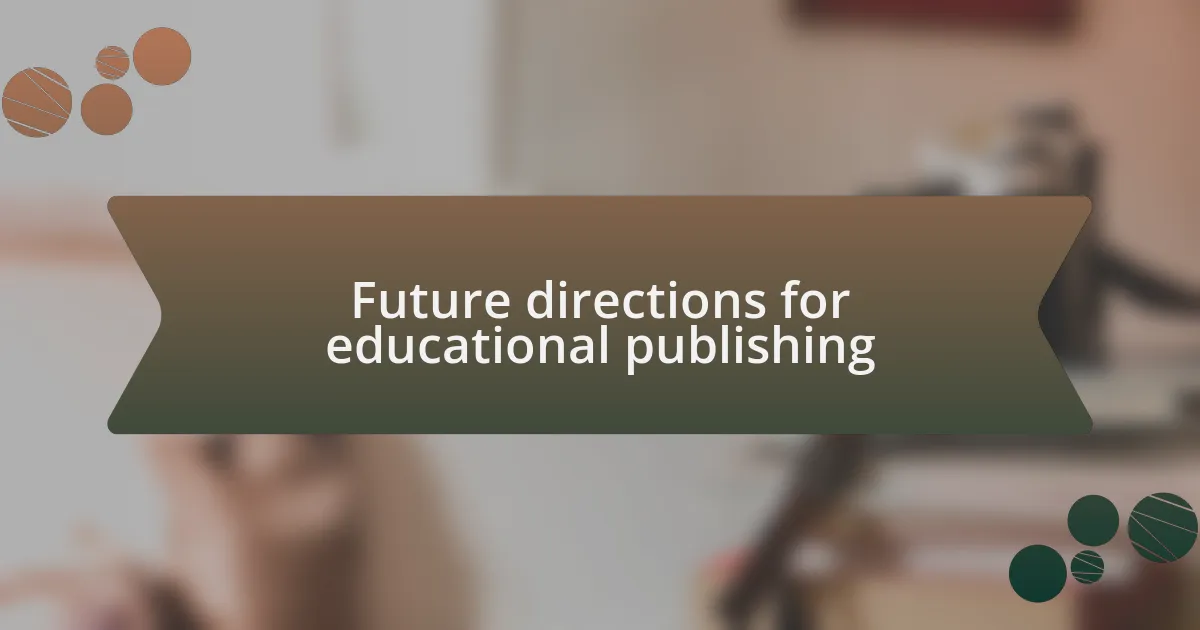
Future directions for educational publishing
The future of educational publishing beckons a shift toward truly inclusive materials. Imagine a world where every student can find themselves in a textbook, not just as an afterthought but woven into the very fabric of the narrative. I’ve often thought about how expanding diverse perspectives in publishing can create an environment where students thrive, fostering a sense of belonging that can otherwise be elusive.
As I consider the integration of technology in future textbooks, I’m excited about the potential for interactive, multimedia content that reflects a variety of cultural narratives. Recently, I experimented with a digital resource that featured voices from around the globe discussing key historical events. The impact on my students was evident; their engagement soared when they realized the complexity of perspectives just waiting to be explored. Don’t you think that tapping into technology can break down traditional barriers and facilitate a deeper understanding of diversity?
Looking forward, it’s crucial for educational publishers to partner with communities to co-create content. I remember attending a roundtable with local educators and writers from various backgrounds, where we brainstormed ideas on curriculum development. The synergy was palpable and sparked innovative ideas that I hadn’t considered before. If educational publishing can harness that kind of collaboration, it could reshape how students interact with learning materials, making their education not just informative, but truly transformative.